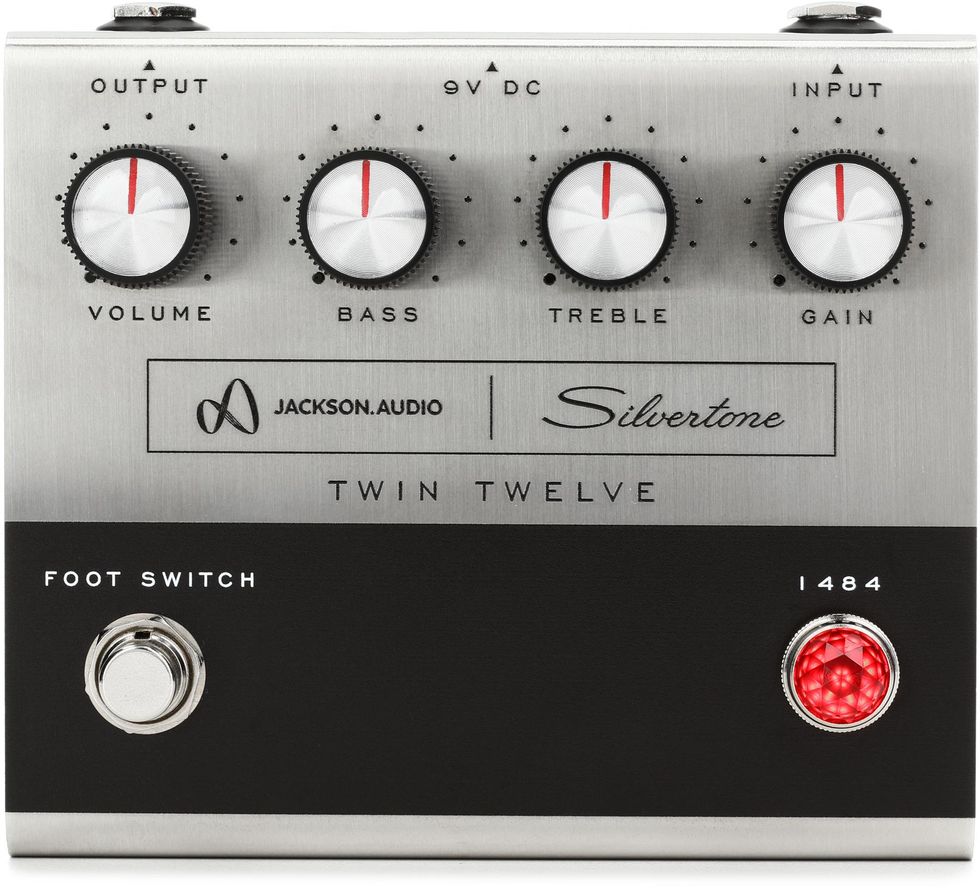Once harvested for peanuts at garage sales and pawn shops—or free for lucky dumpster divers—the Silvertone Model 1484 Twin Twelve amplifier of 1963-’67 graduated to legend status over the past couple decades. Like a lot of ’60s gear with department store catalog origins, Silvertone amps and guitars provided great bang for the buck when they were new. But perhaps no Silvertone product—apart from the company’s Danelectro-built guitars—is as revered as the Twin Twelve. Mudhoney’s Mark Arm and Steve Turner discovered their charms early in their career, and Twin Twelves and their siblings remained backline fixtures for punks, garage rockers, and indie kids. But once the likes of Jack White and Dan Auerbach got on board, the market heated up considerably.
Now a collaboration between the revived Silvertone Guitars and Jackson Audio brings us the Twin Twelve pedal, an overdrive/EQ/booster designed to replicate the tone of the original 1484 piggyback tube amp. To accomplish this, Jackson essentially recreated the topology of the 1484’s preamp, effectively replacing vacuum tubes with JFETs. This method is common for many amp-in-a-box-style pedals. But the result here is a drive of many personalities.
Listen to the demo: https://soundcloud.com/premierguitar/sets/twin-twelve-review
’Round Midnight
The 1484 pedal does a beautiful job of evoking the look of the original 1484 amplifier, including the silver control panel, simple and elegant black lettering, black knobs with silver insets and red indicator lines, red amp-style jewel light, and even the humorous “Foot Switch” legend over the footswitch. What’s more, this pedal seems built to fend off home invaders and stage divers. It’s notably hefty in its heavy-duty folded-steel chassis, which measures 5" x 4" x 2".
Controls include treble, bass, volume, and gain—the latter of which never appeared on the original amp. A look inside the enclosure reveals a lot of space and few components. Juice comes from 9V DC that hits an internal voltage-doubler to improve headroom.
Double Trouble
I tested the Twin Twelve pedal with a Fender Princeton combo and a 65amps London head and 2x12 cab as well as a Gibson Les Paul with humbuckers and a ’50s-style Fender Telecaster, and the first impressions were surprising. Expecting a characterfully sludgy mud machine and grungy pawnshop sonics, I experienced instead a toothsome and impressively versatile overdrive that works in a broad range of genres and playing styles. Fundamentally speaking, the Twin Twelve adds lots of character via a combination of thickness and edgy harmonic content. There’s a barky midrange bite that calls to mind the voice of many catalog amps. But it also has a lot in common with low-gain overdrives, like the Klon and Tube Screamer. Those similarities aside, it has a flavor and sound all its own.
Expecting a characterfully sludgy mud machine and grungy pawnshop sonics, I experienced instead a toothsome and impressively versatile overdrive that works in a broad range of genres and playing styles.
Silvertone may talk a lot about the 1484 as an exact recreation of the Twin Twelve circuit. But in some ways that might sell this pedal short. It’s a great-sounding overdrive by any measure. And, interestingly, it is better at generating American-toned twang, bite, crunch, and lead tones than just about any pedal I’ve played in a while. Clarity and articulation are good, and it makes a great clean boost at lower drive settings while retaining amp-like personality and sensitivity. The pedal is made even more flexible thanks to the 2-band EQ, which provides a lot of room for cutting and boosting the low- and high-frequency bands to taste. It means you have a very flexible boost before you even push your amp into overdrive. It pays similar dividends in overdriven settings, enabling players to explore both the dirtier, thicker side of the American amp tone spectrum or more sparkling variations.
The Verdict
The 1484 Twin Twelve is a great overdrive pedal. And the fact that it doesn’t simply clone one of the already popular drive circuits is a major bonus. The EQ is a great asset, too. But while the 1484 excels at capturing the spirit of the amp that inspired it, I’d argue that with most decent tube amps it sounds better than many real Twin Twelves I’ve played. Certainly, it’s more versatile. And that combination of tone and flexibility make it a very appealing overdrive alternative.












![Devon Eisenbarger [Katy Perry] Rig Rundown](https://www.premierguitar.com/media-library/youtube.jpg?id=61774583&width=1245&height=700&quality=70&coordinates=0%2C0%2C0%2C0)




















